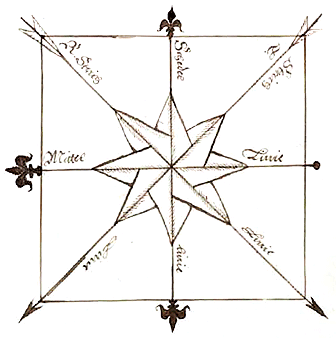Principal Cuts
Throughout his texts on the sword Meyer describes four principle lines of attack that form the principal cutting lines. He enumerates these principale cuts briefly in the section on the longsword and provides further elaboration in the dussack section of the 1570 text, giving extra details not only on the cutting lines themselves, but also on the application of these cuts.
The lines of the cuts themselves are shown in the diagram below, taken from the 1568 text.
Briefly, Meyer enumerates the principal cutting lines as follows.
- First is the vertical line through which a high cut (an oberhauw or schietelhauw) is sent. The is the scalp/parting line (scheittellini) since it divides the combatant into the left and right side.
- Second is the diagonal line downward from above (which he also calls the hanging line) through which we would send a zornhauw cut. Predictably this is referred to as the wrath line (zornlini) or the stroke line (strichlini).
- Third is a horizontal line called the thward or middle line (zwerchlini or mittelini respectively), through which middle cuts are sent (and possibly zwerch cuts as well).
- Finally we have the diagonal rising diagonal line which follows the same path as the zornlini, but comes up from below as in an unterhauw.
The principle cuts along these lines are carried out with the long edge of the sword in their basic form, and these are the principal cuts from which we derive many other techniques.
In learning to cut along these lines Meyer tells us to imagine the centrepoint of the cutting lines converging at the level of the base of the chin. We should practice our cuts along these lines at this level until we have perfected them.
We are also told, however, that as per the section on the four Openings we can attack above or below this line as required.
Advice on Cutting as Your Opponent Cuts
If we are cutting at the same time as our opponent so as to set aside his cut and strike with our own, we are told to adhere to the basic cutting point at the level of this chin. In this way we can be more sure that our blow will set aside that of our opponent, and cutting below this line may mean that we are not adequately protected by our own cut.
Advice on Cutting Before Your Opponent
Conversely if we are cutting first toward our opponent and he is not ready with a cut of his own to counter ours, then we are told that we can attack under or over this chin-level regardless as our attack need not cover us in the same way.
